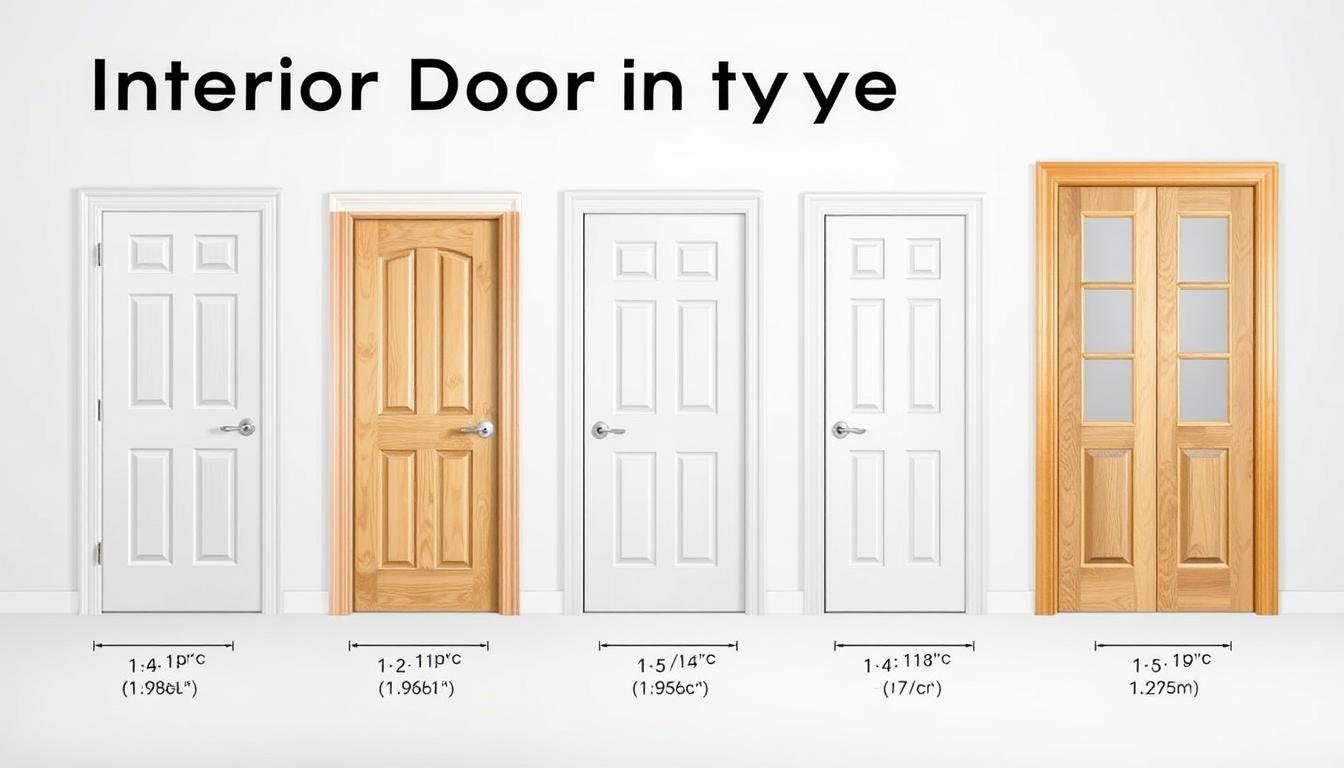Ever struggled with a door that just doesn’t fit right? Improperly measured interior door rough openings can lead to frustrating installation nightmares. Misaligned doors create gaps, uneven surfaces, and can even cause structural issues. These problems can cost you time and money.
The anxiety of renovation setbacks stops now. My guide will show you how to measure an interior door rough opening correctly. I’ll cover the key steps to ensure your door fits perfectly. This will save you stress and prevent expensive mistakes.

Whether you’re a DIY enthusiast or a professional contractor, knowing how to measure interior door rough openings is key. By following my expert advice, you’ll be able to tackle any door installation project with confidence and skill.
Understanding Door Rough Opening Basics
When I start a door installation project, understanding rough openings is key. A rough opening is not just a random size. It’s a space carefully planned for precise door framing.
Preparing for a door opening is more than a quick look. The rough opening is bigger than the door. It gives room for installation, adjustments, and fitting.
What Defines a Rough Opening
A rough opening is the unfinished frame for your door. It has extra space for:
- Door frame placement
- Shimming
- Level adjustments
- Wall thickness accommodations
Why Precise Measurements Matter
Accurate measurements are vital to avoid problems. Small mistakes can cause:
- Doors that don’t close right
- Uneven gaps around the frame
- Hard time hanging the door
- Potential structural issues
Common Measurement Tools Needed
For good door opening prep, have these tools ready:
- Tape measure
- Level
- Carpenter’s square
- Pencil
- Notepad
Remember, precision is essential in framing doors. Take your time, measure well, and check your work. This ensures a perfect fit.
Essential Components of Door Framing
When I work on door installation, knowing the door frame size is key. It depends on several important parts that work together. These parts make the opening stable and functional.
- King studs (full-length vertical supports)
- Jack studs (shorter vertical supports under the header)
- Header (horizontal beam spanning the opening)
- Top plate (horizontal beam at the top)
- Sole plate (horizontal beam at the bottom)
Each part is vital for a stable door frame size. The header is key for supporting weight above the door. Jack studs add support under the header, keeping the frame strong.
Here’s a look at standard rough opening sizes for common interior doors:
| Door Size | Rough Opening Width | Rough Opening Height |
|---|---|---|
| 24 x 80 door | 26 inches | 81 inches |
| 30 x 80 door | 32 inches | 81 inches |
| 36 x 80 door | 38 inches | 81 inches |
When measuring door opening framing, pay close attention to these parts. The top of the trimmer should be 82 5/8 inches above the subfloor. This includes jamb, flooring, and underlayment. Accurate measurements ensure a perfect fit and avoid future problems.
Interior Door Rough Opening Standard Calculations
Knowing door rough-in sizes is key for homeowners and contractors. It helps them get the doorway rough opening dimensions right. Let’s go over the important calculations for a smooth door installation.
Measuring door rough-in sizes needs a specific method. You add extra inches to the door’s size for the perfect fit. This ensures the door fits well and looks great.
Width Calculation Formula
Width calculations are simple. Just add 2 inches to the door’s width. This extra space is for proper alignment and shimming. Here’s a quick guide:
- 24″ door = 26″ rough opening width
- 30″ door = 32″ rough opening width
- 36″ door = 38″ rough opening width
Height Measurement Guidelines
Height measurements need a bit more thought. For most interior doors, add 2.5 inches to the door’s height. This allows for leveling and accounts for floor variations.
Standard Size Charts
| Door Size | Rough Width | Rough Height |
|---|---|---|
| 24″ x 80″ | 26″ | 82.5″ |
| 30″ x 80″ | 32″ | 82.5″ |
| 36″ x 80″ | 38″ | 82.5″ |
Keep in mind that humidity can affect these measurements. In humid areas, add an extra 1/8 inch. This helps with wood expansion.
Measuring Techniques for Width and Height
Measuring interior door openings needs precision and care. I’ll show you how to get the right fit for your door.
- Measure the width in three spots:
- Top of the opening
- Bottom of the opening
- Center of the opening
- Measure from one jack stud to the other
- Use the smallest measurement for alignment
Use a good tape measure and watch for wall issues. The rule for width is: Door width + 2 inches = Rough Opening Width.
For height, follow these steps:
- Measure from the header to the floor or slab
- Check on:
- Left side
- Center
- Right side
- Choose the smallest height
Remember, for height, add 1 inch to the door height. This extra inch helps with installation.
Here are some examples to guide you:
- 24-inch door: Width = 26 inches, Height = 81 inches
- 36-inch door: Width = 38 inches, Height = 81 inches
- Prehung 36-inch door: Width = 38 inches, Height = 82 inches
Always double-check your measurements. Use a level to make sure everything is square. Accurate measurements avoid future problems and ensure a professional finish.
Understanding Door Jamb Width Requirements
When you’re installing a new door, getting the door jamb measurements right is key. The width of the door jamb affects how well your door works and looks. I’ll share important tips to help you pick the right jamb size for your project.
Determining the Right Jamb Width
The thickness of your wall is a big factor in choosing the right jamb width. It’s smart to measure your wall’s total thickness. This includes:
- Wall stud thickness (2×4 or 2×6)
- Sheetrock thickness (usually 1/2″ or 5/8″)
Here’s a quick guide for wall thickness and jamb sizes:
| Stud Type | Sheetrock | Jamb Width |
|---|---|---|
| 2×4 Stud | 1/2″ Sheetrock | 4-5/8″ Jamb |
| 2×4 Stud | 5/8″ Sheetrock | 4-7/8″ Jamb |
| 2×6 Stud | 1/2″ Sheetrock | 6-5/8″ Jamb |
Pro Measurement Tips
Always add 3/4 inch to your wall thickness for shimming. In humid areas, add another 1/8 inch for wood expansion. Accurate door jamb measurements lead to a smooth install and avoid future problems.
Read also: Waterproofing Basement Walls from Inside
Common Mistakes to Avoid When Measuring

Measuring a door rough opening might seem easy, but even pros can make big mistakes. Knowing these common errors can save you time, money, and stress when installing your interior door.
When measuring a door rough opening, being precise is essential. Small mistakes can cause big problems, affecting how well the door works and looks.
- Forgetting to account for flooring thickness, which can cause the door to drag or not close properly
- Failing to measure at multiple points, as walls are rarely perfectly straight
- Ignoring wall depth, which can result in an improper frame fit
- Not ensuring the interior door rough opening is level and plumb
I’ve seen many DIY projects fail because of simple measurement mistakes. The key to a successful door installation is knowing that every wall is different. Walls can have small variations that affect your door’s fit.
| Measurement Error | Potential Consequence |
|---|---|
| Incorrect wall thickness measurement | Mismatched jamb width |
| Not accounting for new flooring | Door unable to swing properly |
| Ignoring local building codes | Potential renovation complications |
Pro tip: Always double-check your measurements before cutting or installing. A few extra minutes of careful measurement can prevent costly mistakes in your door rough opening preparation.
Door Frame Size Adjustments and Shims
Installing a door is more than just measuring and hanging. It’s about making sure it fits perfectly for smooth operation and a professional look. Shims are key to getting a proper fit and handling size differences in door frames.
When I install doors, I’ve found that no rough opening is perfectly square. That’s when shims become your best friend for a precise installation.
Purpose of Shims
Shims are thin, wedge-shaped pieces, usually made of wood or plastic. They help you:
- Level the door frame
- Adjust for uneven wall surfaces
- Ensure proper alignment
- Fill small gaps between the frame and wall studs
Proper Shimming Techniques
To get the best door frame size adjustment, follow these steps:
- Measure the rough opening at top, middle, and bottom
- Check the frame is level using a carpenter’s level
- Place shims at critical points near hinges and strike plate
- Ensure even spacing between shims
- Trim excess shim material carefully
Remember, a proper door fit needs patience and precision. By using shims wisely, you’ll get a professional installation that looks seamless and works perfectly.
Advanced Tips for Wall Opening Dimensions
Getting the right wall opening dimensions is all about precision and prep. When you’re getting ready for a door, some advanced tips can really help. They can save you a lot of time and headaches.
Professional door installers know that not all wall openings are perfectly square. To get a perfect fit, measure in three key spots:
- Top of the rough opening
- Middle of the rough opening
- Bottom of the rough opening
It’s also important to check if the wall is level and plumb. I use special tools to make sure I’m accurate:
- Tape measure with clear markings
- Professional level
- Framing square
- Laser measuring tool (optional but recommended)
Read also: How to Install a Bathroom Vent through a Wall Easily
The climate where you live also matters when preparing for a door. Different places need different strategies:
| Climate Zone | Measurement Adjustment | Material Recommendation |
|---|---|---|
| Humid Regions | Add 1/8″ extra space | Moisture-resistant materials |
| Desert Areas | Account for wood shrinkage | Thermally stable wood |
| Coastal Zones | Corrosion-resistant framing | Waterproof materials |
Using these advanced methods, you’ll make a top-notch rough opening. It will handle different doors and weather conditions well.
Proper Door Fit and Clearance Guidelines
Getting the right door fit is key for both looks and function in rooms. When putting in interior doors, knowing the clearance needs is vital. It greatly affects how well your door works and looks in its frame.
To get a door that fits right, focus on several important clearance measurements. These steps help your door open and close smoothly. They also prevent problems with how the door works over time.
Floor Clearance Considerations
Floor clearance is very important when installing interior doors. Here are some key tips:
- For hardwood floors: Leave about 1/2 inch clearance
- For carpeted floors: Allow 3/8 inch clearance for the carpet’s thickness
- Use shims to keep spacing even during installation
Side and Top Clearances
Getting the door fit right means precise measurements around the door frame. Here are some recommended clearances:
- Side gaps: 1/8 to 1/4 inch on each side
- Top gap: About 1/4 inch
- Make sure spacing is even to avoid rubbing or sticking
By following these guidelines, you’ll get a professional-looking door installation. It will also allow for natural wood movement and changes in flooring. Paying attention to proper door fit ensures your door works smoothly for many years.
Special Considerations for Different Door Types

Not all interior doors are the same. Each type needs its own way to measure door rough-in sizes. Knowing these differences is key to a perfect fit for your project.
Working with interior doors, I’ve found each type needs special attention to measurements. Here are some important points for different door setups:
- Solid Wood Doors
- Need precise rough opening measurements
- Dimensions vary with wood type and construction
- Hollow Core Doors
- They’re light and affordable
- Must have very accurate rough opening calculations
- Double Doors
- Rough opening width = 2x door width + 2 inches
- Needs extra care for alignment and clearance
For double doors without an astragal, calculate the rough opening by doubling the door width and adding two inches. This ensures enough space for installation and smooth operation.
Special doors like bifold and pocket doors have their own measurement needs. Bifold doors need a rough opening width that’s the door width plus two inches, with similar height needs. Pocket doors require even more precise measurements for smooth sliding in the wall.
Always measure from outside drywall to outside drywall, including the thickness of the finished floor. Taking the time to learn these detailed measurement techniques will save you trouble during installation.
Conclusion
In this guide, I showed you how to measure interior door openings accurately. Getting the measurements right is key for a successful door installation. It’s all about the details that make your project shine.
When measuring, remember to be precise. Every step, from width and height to wall thickness, matters. Local codes and manufacturer specs are not just suggestions. They’re important for a job well done.
With the tips from this guide, you’re ready to take on your door project. Don’t rush the measuring. Double-check your work. If unsure, get help from a pro. A little extra time can save a lot of trouble and money.
Your careful preparation of the rough opening will affect your door’s fit, function, and look. With the right approach, your door installation can be a smooth and beautiful home improvement. It will make your space more functional and attractive.


